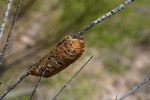
A butterfly’s chrysalis must be positioned correctly or the butterfly will not be able to emerge properly. In the wild, caterpillars often pupate on plants, but in captivity cut stems may die long before the butterfly emerges. Storing the pupae in a shoebox isn’t an option as the incorrect positioning means the butterflies may end up deformed or not survive at all. A simple chrysalis house, however, requires a minimum of skill to build.
What You Need
For the house, you’ll need non-toxic, unpainted, untreated wood, muslin or very fine wire mesh, nails, hinges and stapes or non-toxic glue. A sheet of cork board is necessary to attach the pupae. You’ll also need pins and some scrap paper. This is for species that pupate on plants. The pupae of species, mostly moths, that pupate underground can be left where they are in the caterpillar tank -- which should have had a thick layer of soil on the bottom for such species. Just add a couple of twigs for the emerging insects to climb up.
Procedure
The house itself can be as rudimentary as you like. The two main considerations are sufficient ventilation and protection from pests. A simple wooden box with a muslin front and a lid is perfect. Measure for a box several times the wingspan of the largest butterflies you plan to raise. Attach the pieces together with nails and the lid with hinges. Attach the muslin or mesh to the front with staples or non-toxic glue. Position the cork board inside at a slight angle, allowing the pupae to hang. Temperature and humidity requirements vary, so check the needs of your species.
Attaching the Pupae
Very carefully remove each chrysalis from its plant. Don’t damage the tip. Use a tiny dot of non-toxic glue to attach the tip to a piece of paper. Once the glue has dried, pin the paper with chrysalis to the underside of the cork board, so the chrysalis hangs down. It should be positioned in a similar manner to how it was on the plant, but it doesn’t have to be exact. The primary aim is to ensure the emerging butterfly has plenty of room to expand his wings.
Emergence
When the butterflies emerge depends on the species and the temperature. Some species overwinter in the chrysalis form while others might emerge just a few weeks or less after pupation. The chrysalis often changes color just before the butterfly comes out. Mist the air, not the pupae, with dechlorinated water at this point. Newly hatched butterflies are extremely vulnerable, needing time for their wings to expand and harden. Even the gentlest touch could maim your butterfly at this stage, so leave him alone until his wings are fully extended and solid, a process that could take up to a day. Once he’s moving around, perhaps attempting to fly, and the wings appear normal, transfer him to a butterfly house. Only release butterflies if the caterpillars were wild-caught in your area originally and they are not a pest species.
References
Photo Credits
-
Ablestock.com/AbleStock.com/Getty Images
Writer Bio
Judith Willson has been writing since 2009, specializing in environmental and scientific topics. She has written content for school websites and worked for a Glasgow newspaper. Willson has a Master of Arts in English from the University of Aberdeen, Scotland.




